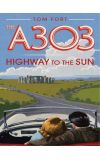
17 May 2013 02:31:11
"We knew the landmarks that measured its progress: maybe a pub sign, a red post-box, an old, sagging stone wall weighed down by ivy … Each delivered the same message. Nearly there now."
Fort does not maintain the same tone or style for the book's remaining 340 pages; nor would he want to, when his subject matter includes various ministers of transport since the 1930s. John Prescott may still stir strong feelings, but Proustian lyricism is not one of them. It is a great start, though, winning us over to the idea of a book that takes as its focus a tarmacked belt along certain sections of which may be found, in high season, thousands of motorists cursing themselves for having chosen this way to the west. And, as Fort observes, cursing themselves all the more loudly on the journey east, when all they have to look forward to when they get back is returning to work.
As for the east-to-west bias of the book, Fort deals with this very wittily early on, and anyone who can spend a page speculating on whether Mrs de Winter "and her creepy husband" took the A303 or the A30 to get to his Cornish home in Rebecca without making us raise our hands in exasperation is going to get my vote.
It is, as one reviewer noted, a plain man's state-of-the-nation book – though one ignoring the major conurbations. In doing so, the conflict between progress and nature is brought into sharp relief. Fort acknowledges that progress has to be made – he even makes a case, which I am too sentimental to endorse without reservation, for the Winchester bypass which so energised the anti-roads lobby back in the 1990s.
The flesh-and-blood example of progress v nature here resides in the case of the great bustard, the world's heaviest flying bird and so, therefore, one of the most impractical, whose attempts to re-establish itself on Salisbury Plain, courtesy of the admirably quixotic Great Bustard Group, would seem to be doomed. (In an aside, Fort has an unkind word for those who have reintroduced beavers to Scotland, and I will take issue with him over that, should we ever meet.)
But the A303 has much history on its side – or to either side. Fort's account of succeeding attempts to explain Stonehenge are worth the detour, and I am inclined to agree with his suggestion that the real reason that nothing has been done about diverting the road away from the stones is not due to the intransigence of the various departments, but down to the fact that, deep down, we kind of like the arrangement of road and monument the way it is.
Scandal-lovers will be thrilled by the rape and sodomy charges against the Second Earl of Castlehaven in 1631. Fort does not mention that the events prompted the creation, in a roundabout way, of Milton's Comus; I do, probably just to show off. But I did not know a very great deal else that is here, and it is the millennia-spanning nature of the book that gives it its charm and point. Few books can include both Stonehenge and Barbara Castle.

